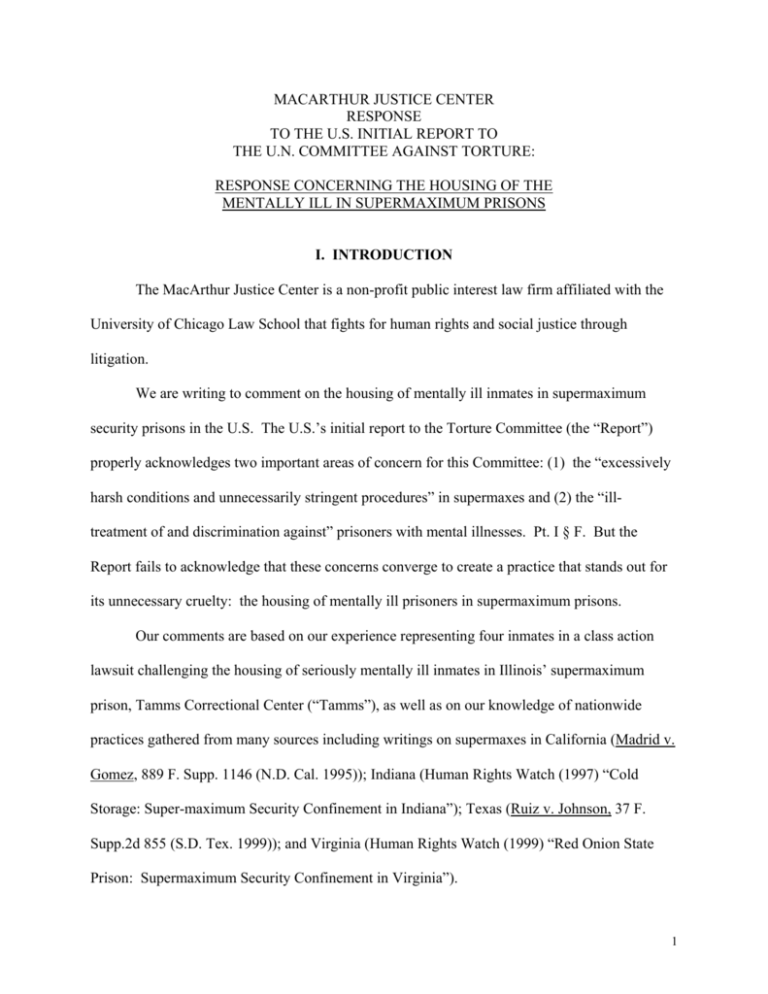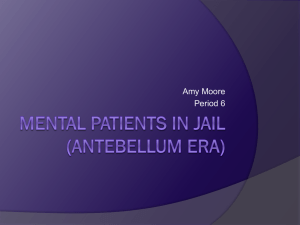LETTER to United Nations Committee Against Torture
advertisement

MACARTHUR JUSTICE CENTER RESPONSE TO THE U.S. INITIAL REPORT TO THE U.N. COMMITTEE AGAINST TORTURE: RESPONSE CONCERNING THE HOUSING OF THE MENTALLY ILL IN SUPERMAXIMUM PRISONS I. INTRODUCTION The MacArthur Justice Center is a non-profit public interest law firm affiliated with the University of Chicago Law School that fights for human rights and social justice through litigation. We are writing to comment on the housing of mentally ill inmates in supermaximum security prisons in the U.S. The U.S.’s initial report to the Torture Committee (the “Report”) properly acknowledges two important areas of concern for this Committee: (1) the “excessively harsh conditions and unnecessarily stringent procedures” in supermaxes and (2) the “illtreatment of and discrimination against” prisoners with mental illnesses. Pt. I § F. But the Report fails to acknowledge that these concerns converge to create a practice that stands out for its unnecessary cruelty: the housing of mentally ill prisoners in supermaximum prisons. Our comments are based on our experience representing four inmates in a class action lawsuit challenging the housing of seriously mentally ill inmates in Illinois’ supermaximum prison, Tamms Correctional Center (“Tamms”), as well as on our knowledge of nationwide practices gathered from many sources including writings on supermaxes in California (Madrid v. Gomez, 889 F. Supp. 1146 (N.D. Cal. 1995)); Indiana (Human Rights Watch (1997) “Cold Storage: Super-maximum Security Confinement in Indiana”); Texas (Ruiz v. Johnson, 37 F. Supp.2d 855 (S.D. Tex. 1999)); and Virginia (Human Rights Watch (1999) “Red Onion State Prison: Supermaximum Security Confinement in Virginia”). 1 We write to discuss four issues. 1. The housing of severely mentally ill men under the “excessively harsh conditions and unnecessarily stringent procedures” at supermax facilities like Tamms (Pt. I § F) brings agony to the men subjected to this practice. The practice undeniably violates both the Torture Convention’s prohibition against punishment by the intentional infliction of severe mental pain and suffering (Article 1) and its prohibition against cruel, inhuman, or degrading treatment or punishment (Article 16). 2. Because the U.S. has failed to identify the practice of housing mentally ill inmates at supermaxes as a problem under the Torture Convention, it has failed to work to prohibit or to investigate or prosecute this practice in instances where it amounts to psychological torture, or to encourage states to do so. 3. The U.S. also has taken actions that hinder the efforts of mentally ill inmates housed at supermaxes to pursue remedies on their own behalves. This has been accomplished through Congress’s enactment, and the courts’ interpretation of, a statute that requires all prisoners to meet certain very specific procedural requirements before filing civil lawsuits. The statute and its harsh interpretation have left the mentally ill prisoners most devastated by their experiences at supermaxes unable to get to court where lawyers can help plead their cases, because they cannot comply with the procedural prerequisites. 4. The U.S. has further curtailed the rights of mentally ill prisoners at supermaxes by limiting their rights once they get to court. This has been accomplished through Congress’s enactment, and the courts’ interpretation of, a statute that curtails the rights of prisoners when they seek relief based on psychological – instead of physical – injury. 2 II. SPECIFIC ISSUES 1. Seriously Mentally Ill Inmates Should Not Be Housed At Supermaxes. (Articles 1 and 16: Torture and Cruel, Inhuman, or Degrading Treatment) The “excessively harsh conditions and unnecessarily stringent procedures” that typify supermaxes are acknowledged by the Report and have been documented extensively; the conditions in Illinois’ supermax are described in detail in the Amended Complaint (¶¶ 33-41) for our lawsuit (Boyd v. Snyder, 99-280-DRH, pending in the Southern District of Illinois). A copy of the Amended Complaint is included here as an exhibit. Yet, while some supermaxes exclude the mentally ill, many others allow them to be placed there or to remain when they deteriorate significantly. See Chase Riveland (1999) “Supermax Prisons: Overview and General Considerations,” Washington, D.C., U.S. Department of Justice, National Institute of Corrections, pp. 3-4. At supermaxes, certain mentally ill inmates or those with preexisting mental conditions that make them vulnerable to deterioration in supermax conditions develop a variety of problems. These include auditory and visual hallucinations, overt paranoia, hypersensitivity to external stimulation, aggressive fantasies, problems with concentrating and with controlling impulses, anxiety/panic disorder, and overt psychotic disorganization, as well as physical trauma from suicide attempts and self-mutilation. Inmates who begin to experience these serious psychological injuries become caught in a cycle that worsens their illness and makes their pain worse. Their pain makes them act destructively toward themselves, their environment, or the staff. Their destructive conduct brings more punishment, which in turn increases their pain and their destructiveness. Exhibit, ¶¶ 29-30 and throughout. 3 Repeatedly, supermax officials punish the mentally ill for conduct caused by their mental illnesses. The punishments come in the form of brutal cell extractions in which inmates’ eyes and face are sprayed with mace and a team of guards drags them from their cells, and by disciplinary tickets ordering them to pay the prison for the torn sheets and swallowed razor blades they used to try to kill themselves. Some are medicated with heavy doses of antipsychotic drugs, often against their will; others are labeled malingers yet denied medication on the ground they may use it to kill themselves. Exhibit, ¶¶ 31-32 and throughout. Undeniably, housing mentally ill inmates in supermax prisons may constitute “psychological torture” (Madrid v. Gomez, 889 F.Supp. at 1264) and, as such, the practice violates the Eighth Amendment to the U.S. Constitution as well as the Torture Convention’s prohibitions against torture and cruel, inhuman, and degrading treatment. The U.S. should adopt a national policy that condemns this practice. Once articulated, the policy can be implemented through systemic mental health screening and evaluation programs that prevent seriously mentally ill inmates from being sent to supermaxes and through ongoing monitoring programs that remove those who deteriorate. 2. The U.S. Must Confront This Problem and Work To Prohibit It. (Articles 2 and 12: Prohibition and Prompt, Impartial Investigation of Torture) The housing of mentally ill prisoners in supermaxes is a significant problem. Sixteen percent of all state prisoners are mentally ill, and nearly 2 percent of the U.S.’s 2 million prisoners are housed in 57 supermaximum prisons and units that are run by 34 states and the federal government. U.S. Department of Justice (July 1999) Bureau of Justice Statistics Special Report: Mental Health and Treatment of Inmates and Probationers; Sentencing Project (1999) Prison Populations, “Projections and Analysis”; Roy King (1991) “Maximum-Security Custody 4 in Britain and the USA,” British Journal of Criminology 31:126-52; and U.S. Department of Justice, National Institute of Corrections (1997) Supermax Housing: A Survey of Current Practices. p. 3. These vast numbers should be a source of international concern; yet they are not mentioned in the Report. The Report says that if torture occurs “as a matter of policy” it constitutes “a serious criminal offense” that will be prosecuted. Yet the U.S. can point to no instance where either state or federal governments have investigated the housing of mentally ill inmates in supermaxes, and no instance where the government has filed criminal or civil charges for systemic practices at supermaximum prisons. The U.S.’s silence about the “psychological torture” of mentally ill prisoners in supermaxes is lamentable. It violates the Torture Convention’s requirement that state parties work to prohibit torture and that they promptly and impartially investigate legitimate allegations of torture. The U.S. should begin at once to direct some of its massive educational, investigative, and prosecutorial resources toward these goals. 3. Prison Grievance Procedures Are Inadequate and a Barrier to Filing Suit. (Articles 13 and 14 – Right to Complain and Private Right of Redress and/or Compensation) As the Report points out, the prison’s internal grievance procedure is the primary mechanism for prisoners to make complaints about conditions of confinement. Pt. II Art. 13. Both federal and state prisons have mandatory, often three-tiered grievance systems with many procedural hurdles. See, for example, 28 C.F.R. Part 542 (federal procedures) and 20 Ill. Adm. Code § 504.800 et seq. (Illinois procedures). Because of their disabilities, mentally ill inmates often have difficulty understanding their rights and communicating their needs in the grievance process. The difficulty intensifies at 5 supermaxes, where the isolated environment exacerbates the prisoner’s illness and restrictive rules mean the prisoner cannot seek help from the “jailhouse lawyers” who often provide assistance at other prisons. Exhibit ¶ 35. Even if mentally ill prisoners can overcome these obstacles, their grievances will not solve the issue at the heart of most of their complaints, which is that they suffer psychological torture because they are housed at supermaxes. The grievance process is designed for minor disputes that can be resolved by recourse to departmental rules, not for challenges to the systemic policies that allow (and sometimes encourage) the housing of mentally ill at supermaxes. The proper forum for challenging such policies is the federal courts, where prisoners can assert systemic claims based on the U.S. Constitution and other applicable laws. But the Prison Litigation Reform Act of 1996 (“PLRA”) has made exhaustion of administrative remedies a prerequisite to a prisoner’s filing a lawsuit under federal law. 42 U.S.C. § 1997e(a). The exhaustion requirement superficially seems reasonable; but for mentally ill supermax inmates it is an awesome barrier. Yet until the prisoner has exhausted his administrative remedies he and his lawyers may not file a lawsuit. Allowing PLRA-mandated exhaustion of remedies to serve as a barrier to mentally ill inmates who seek relief from the courts violates the Torture Convention, because it interferes with the rights of torture victims to complain to competent authorities and to seek redress for their claims. The rule should be recast to take into account a prisoners’ mental disability when this illness makes communication difficult or impossible. 4. The PLRA’s Limitation for Emotional Injury Violates the Torture Convention. (Articles 13 and 14 – Right to Complain and Private Right of Redress and/or Compensation) 6 The PLRA contains another barrier to the right of mentally ill prisoners to redress grievances, namely, the Act’s “limitation on recovery” section. The statute says that no federal civil action may be brought “for mental or emotional injury . . . without a prior showing of physical injury.” 42 U.S.C. §1997e(e). The Report (Pt. II Art. 13) says the statute means that plaintiffs must “show physical injury to receive damages for mental or emotional injury suffered while in custody” and concedes that the statute therefore “is not fully consistent with U.S. obligations under the Torture Convention.” But when psychological torture is the heart of the plaintiff’s claim (and not just an element of damages), the effect of this statute may be even more devastating, for the courts have yet to agree on the contours of the statute. Whatever the meaning, this “limitation on recovery” statute is a step backward from modern thought, which gives equal legitimacy to mental and physical problems and to psychological and physical torture, and which condemns improper mental health treatment along with improper medical treatment. The statute violates the Torture Convention and U.S.’s interpretation of torture under the Convention. It should be rescinded by the U.S. Congress. III. CONCLUSION The Torture Committee should use its efforts to require the U.S. to do the following: 1. Adopt a national policy that condemns the housing of mentally ill inmates in supermax prisons. 2. Direct some of the country’s massive educational, investigative, and prosecutorial resources at this serious human rights problem. 3. Restructure the exhaustion of remedies mandate of the PLRA to take account of prisoners’ mental disabilities when the illnesses make communication difficult or impossible. 7 4. Rescind the “limitation on recovery” section of the PLRA, which penalizes claims for psychological torture. Respectfully submitted, Jean Maclean Snyder Trial Counsel On behalf of MacArthur Justice Center Prepared with the assistance of Robin McPherson law student at the University of Chicago Law School dated: May 1, 2000 8








